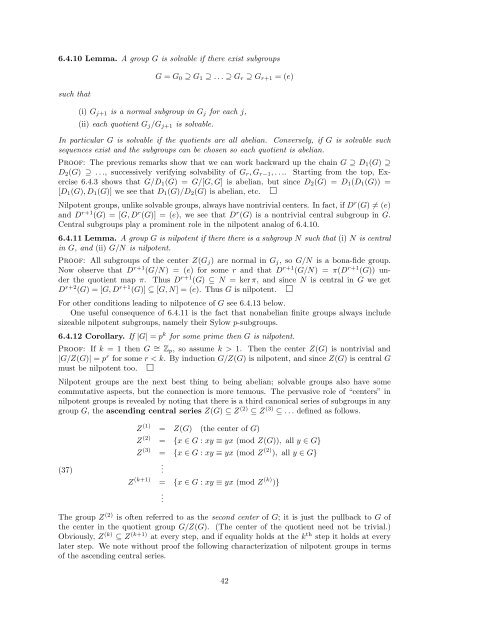Algebra I: Section 6. The structure of groups. 6.1 Direct products of ...
Algebra I: Section 6. The structure of groups. 6.1 Direct products of ...
Algebra I: Section 6. The structure of groups. 6.1 Direct products of ...
Create successful ePaper yourself
Turn your PDF publications into a flip-book with our unique Google optimized e-Paper software.
<strong>6.</strong>4.10 Lemma. A group G is solvable if there exist sub<strong>groups</strong><br />
such that<br />
G = G0 ⊇ G1 ⊇ . . . ⊇ Gr ⊇ Gr+1 = (e)<br />
(i) Gj+1 is a normal subgroup in Gj for each j,<br />
(ii) each quotient Gj/Gj+1 is solvable.<br />
In particular G is solvable if the quotients are all abelian. Conversely, if G is solvable such<br />
sequences exist and the sub<strong>groups</strong> can be chosen so each quotient is abelian.<br />
Pro<strong>of</strong>: <strong>The</strong> previous remarks show that we can work backward up the chain G ⊇ D1(G) ⊇<br />
D2(G) ⊇ . . ., successively verifying solvability <strong>of</strong> Gr, Gr−1, . . .. Starting from the top, Exercise<br />
<strong>6.</strong>4.3 shows that G/D1(G) = G/[G, G] is abelian, but since D2(G) = D1(D1(G)) =<br />
[D1(G), D1(G)] we see that D1(G)/D2(G) is abelian, etc. �<br />
Nilpotent <strong>groups</strong>, unlike solvable <strong>groups</strong>, always have nontrivial centers. In fact, if D r (G) �= (e)<br />
and D r+1 (G) = [G, D r (G)] = (e), we see that D r (G) is a nontrivial central subgroup in G.<br />
Central sub<strong>groups</strong> play a prominent role in the nilpotent analog <strong>of</strong> <strong>6.</strong>4.10.<br />
<strong>6.</strong>4.11 Lemma. A group G is nilpotent if there there is a subgroup N such that (i) N is central<br />
in G, and (ii) G/N is nilpotent.<br />
Pro<strong>of</strong>: All sub<strong>groups</strong> <strong>of</strong> the center Z(Gj) are normal in Gj, so G/N is a bona-fide group.<br />
Now observe that D r+1 (G/N) = (e) for some r and that D r+1 (G/N) = π(D r+1 (G)) under<br />
the quotient map π. Thus D r+1 (G) ⊆ N = kerπ, and since N is central in G we get<br />
D r+2 (G) = [G, D r+1 (G)] ⊆ [G, N] = (e). Thus G is nilpotent. �<br />
For other conditions leading to nilpotence <strong>of</strong> G see <strong>6.</strong>4.13 below.<br />
One useful consequence <strong>of</strong> <strong>6.</strong>4.11 is the fact that nonabelian finite <strong>groups</strong> always include<br />
sizeable nilpotent sub<strong>groups</strong>, namely their Sylow p-sub<strong>groups</strong>.<br />
<strong>6.</strong>4.12 Corollary. If |G| = p k for some prime then G is nilpotent.<br />
Pro<strong>of</strong>: If k = 1 then G ∼ = Zp, so assume k > 1. <strong>The</strong>n the center Z(G) is nontrivial and<br />
|G/Z(G)| = p r for some r < k. By induction G/Z(G) is nilpotent, and since Z(G) is central G<br />
must be nilpotent too. �<br />
Nilpotent <strong>groups</strong> are the next best thing to being abelian; solvable <strong>groups</strong> also have some<br />
commutative aspects, but the connection is more tenuous. <strong>The</strong> pervasive role <strong>of</strong> “centers” in<br />
nilpotent <strong>groups</strong> is revealed by noting that there is a third canonical series <strong>of</strong> sub<strong>groups</strong> in any<br />
group G, the ascending central series Z(G) ⊆ Z (2) ⊆ Z (3) ⊆ . . . defined as follows.<br />
(37)<br />
Z (1) = Z(G) (the center <strong>of</strong> G)<br />
Z (2) = {x ∈ G : xy ≡ yx (mod Z(G)), all y ∈ G}<br />
Z (3) = {x ∈ G : xy ≡ yx (mod Z (2) ), all y ∈ G}<br />
.<br />
.<br />
Z (k+1) = {x ∈ G : xy ≡ yx (mod Z (k) )}<br />
.<br />
<strong>The</strong> group Z (2) is <strong>of</strong>ten referred to as the second center <strong>of</strong> G; it is just the pullback to G <strong>of</strong><br />
the center in the quotient group G/Z(G). (<strong>The</strong> center <strong>of</strong> the quotient need not be trivial.)<br />
Obviously, Z (k) ⊆ Z (k+1) at every step, and if equality holds at the k th step it holds at every<br />
later step. We note without pro<strong>of</strong> the following characterization <strong>of</strong> nilpotent <strong>groups</strong> in terms<br />
<strong>of</strong> the ascending central series.<br />
42

















